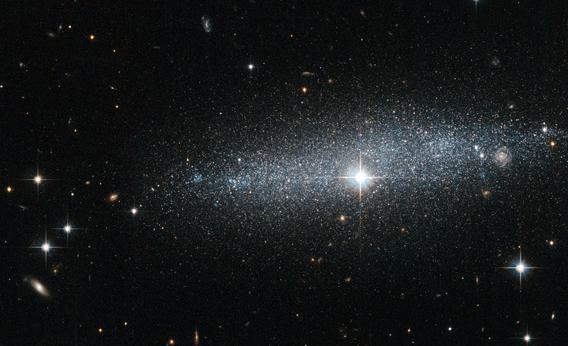Create a free profile to get unlimited access to exclusive videos, sweepstakes, and more!
Tiny Galaxy Sparkles in Our Back Yard

The diversity of nature constantly surprises me. If you asked me what the first thing Iâd think of if you shouted the word âgalaxyâ at me, it would be something like the Milky Way: a large, disk-shaped pinwheel studded with stars, festooned with bright gas clouds, and splotched with dark dust clouds
Not all galaxies are like that, though. Some are puffy, some are elongated, some are just weird (technically, classified as âpeculiarâ). And then thereâs ESO 318-38, a nearby galaxy thatâs something of an underachiever when it comes to size, but that more than makes up for it in, well, glitteriness:
Not much is really known about this galaxy. I searched through the professional journals and found only one paper about it, where the astronomers examined 450 nearby galaxies to determine some of their basic physical characteristics (our friend here is listed as âP32250â, if youâre curious). In this case, we know itâs roughly 20 to 30 million light years away, and pretty small. Judging from its brightness itâs only about 1 percent or less the mass of our Milky Way, and as you can see by the picture, itâs mostly stars! Thereâs not a hint of gas or dust.
For a moment I was thrown by the stars being all blue, since only hot, young, massive stars are that color. That would be pretty weird, because stars are born from huge gas clouds, and there arenât any that are obvious in this picture! But then I checked and saw that in this picture, what you see as blue is actually light from the orange/red part of the spectrum. In other words, this is false color. The astronomers used two filters to make this picture, one that lets through only orange/red light (shown as blue), and another that lets through only infrared light (shown as red). Those two colors are useful when youâre looking at stars, and they make for a pretty picture, but you have to be careful interpreting the picture!
So this looks to be an ordinary dwarf galaxy, fairly flat, and otherwise unremarkable except for its beauty.
If you grab the bigger version youâll notice a couple of things. One is that there are lots of stars scattered across the field. Those are foreground stars, ones in our own galaxy. Weâre inside the Milky Way, looking out at ESO 318-38, so nearby stars get in the wayâthink of it as looking out of a slightly dirty window at houses in the distance.
The other thing youâll notice is that the picture is littered with lots of far more distant background galaxies. You can easily spot several dozen, many red and smudgy-looking. One, though, is a face-on spiral we can see right through ESO 318-38! Thatâs another indication our little friend is mostly stars and doesnât have much gas and dust. If it did, then that more distant galaxy would be heavily obscured, but as it is we can see it pretty well. So this is like looking out a slightly dirty window to a distant house and seeing through its slightly dirty windows to a house even farther away. Except in this case looking isnât rude or borderline illegal.
It never occurred to me before, but astronomy is the ultimate in voyeurism. We get to peek in on our neighbors, and itâs totally acceptable! In fact, I encourage it.
The metaphorical cosmic neighbors, I mean. Donât take me too literally. And if you do, youâre on your own.














